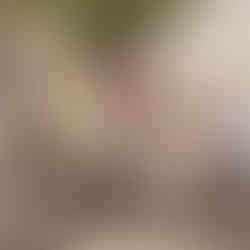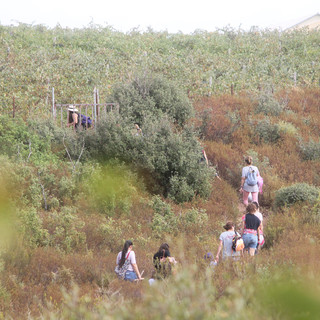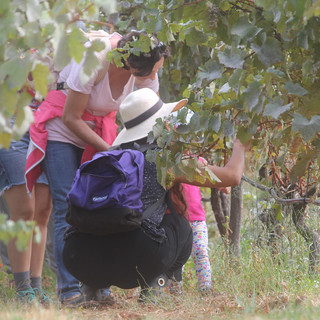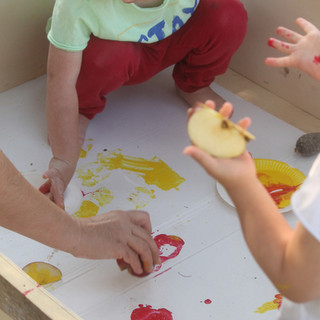An Autumn Recipe
- Natalia Kokotou
- Oct 4, 2016
- 4 min read

Our day can be easily divided into before picnic time and after picnic time. The picnic itself is quite an elaborate affair, anticipated by children and adults alike. It is a welcome break after the more laborious work of the morning; it provides for plenty of learning opportunities; it is a time for everyone to relax and enjoy each other’s company before parents and children go their separate ways.
We start our morning in the vegetable garden where our seeds have begun to sprout: those on the garden beds and those that were planted by the children in pots. We find a sizable hole in the potato patch and discuss which animal might have been digging in the night. The days are still warm and there is watering to be done. The ponies need lots of hay since the fields are bare after an extended dry season. The chickens, ducks and rabbits all need tending to, and the children watch on and help out wherever they can. Now the older ones are used to the routine, they are quick to offer help.
There is also a lot of digging and building and balancing, as various materials are lying about, inspiring impromptu games. Next, is the long hike up the forest path that will lead us to our picnic. So, as tummies begin to rumble and the first noises in the direction of food are made, we know it is time to move on. We walk through the vineyard, past sweet grapes still clinging to the vines at just the right height to be picked and stuffed into a small person’s mouth.
The memory of pressing grapes is still vivid in the children’s minds: one little boy muses while plucking the grapes that he will squash them to make some wine. Today we used grape must to make something appropriate for under age consumers: moustalevria. A familiar flavor for some children and for others something quite new, but it is a novelty for everyone to be consuming the product of their own grape squashing.
We gather at the picnic spot, under a cluster of tall pines, and set about preparing for the meal. There is a plate in the middle of the blanket where the children can place some food they want to share; we call it the "sharing plate". Today there is a lovely collection of autumnal delicacies: nuts, raisins and dried apricots. Usually we provide fresh bread that we spread with a nut butter but today of course we are having moustalevria as a treat.
There are oranges with a cutting board, a knife and an orange squeezer set out on a low table. The children take turns making orange juice for themselves. The table is at the right height for them to go through all the steps of cutting and squeezing the oranges and then pouring the juice into a cup by themselves, resulting in a very satisfying drink.
Once the picnic is over, the children go off with the teachers to spend the rest of the day by the ponds where there are always new and intriguing things set up as well as familiar favorites.
Today, in full seasonal swing, there is a table of autumnal curiosities: walnuts, dry leaves, ripe pine cones and chestnuts. Once the children have had a feel of them it's time to use them to make art, in shades of red, yellow and orange.
Recipe for Moustalevria (serves 10)
It is, as its name suggests pure grape must and flour heated until thick and then chilled; the result being similar to thick custard (in texture rather than flavor). Although there is no added sugar, it can, depending on the grape variety, be very sweet. I like to add the juice of half a lemon to balance this.

Ingredients:
6 cups grape must (If you can’t get your hands on clean must then you could try fresh grape juice instead)
Juice of ½ a lemon
1 cup spelt flour
2 sticks of cinnamon
Ground cinnamon and sesame to serve
Method:
Separate 1 cup must to dissolve flour in and set aside
Heat grape must over medium heat
Just before it reaches boiling point pour the dissolved flour through a sieve to avoid lumps.
Add lemon juice (optional)
Use a wire whisk to stir constantly while simmering.
After about half an hour the mixture should have thickened.
You can test this by putting a drop of it on a wet plate and drawing a line through with your finger. If the line remains it is ready, if the liquid runs back keep on stiring.
Once it has thickened, remove the cinnamon sticks and pour the liquid into 10 ramekin dishes.
Sprinkle cinnamon and sesame on top of each, allow to cool. Chill in the fridge until ready to serve.
(moustalevria is best served chilled)
“Cutting” or “Cleaning” fresh grape must
If you happen to have access to a winery and can get fresh grape must straight from the press; you will need to “cut” it as they say, or clean it.
In order to do this you will need 1 tbsp of ash (from a clean wood fire) per Liter of must.
Method:
Place must with ash (1 tbsp/ Liter) in a large pan and place over medium heat.
As froth begins to form on the top, scoop it off using a slotted spoon.
Continue to do so until no more froth forms.
Remove from heat and allow to settle.
After 12 hours, transfer liquid slowly to another pan allowing any impurities to remain at the bottom.
Transfer again into a clean pot, this time passing the liquid through a cheese cloth.
The liquid should now be clear and is ready to use immediately or to freeze for up to a year.


























































Comments